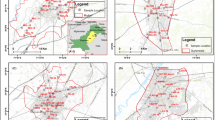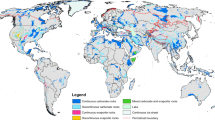Abstract
Characterization of the groundwater flow systems can be used in conjunction with the geochemical evolution of groundwater to assess water–rock interaction processes, time of residence, and the regional hydrogeochemical evolution system. To identify the regime of groundwater flow, we consider it is essential to localize the geographic components of the hydrologic cycle, where the geologic environment determines the functional areas such as the recharge and discharge areas and the dynamics of water availability of the aquifer, as well as water quality. In this paper, we analyzed the groundwater flow systems on a section of chalky rocks, known as Plataforma Valle-San Luis Potosí (PVSL), located in the state of Tamaulipas, Northeast Mexico. The groundwater from the study area has dissolved Ca2+ and HCO3− as dominant ions; average concentrations are 118.9 and 253.9 mg/L, respectively. Thought to be derived from calcite dissolution, basically under the influence of the massif of the Sierra Madre Oriental, a karst Quaternary environment denominated El Abra Formation, a sedimentary rocks geology that dominates the regional geology. We used the cluster analysis to classify the primary element concentrations in two groups and three subgroups, where we could identify a local, intermediate, and regional flow. Defining the evolution of groundwater from recent waters on Ca2+ to HCO3− and dominance of SO4−2 to waters with more residence period, associated with the dissolution of gypsum from the Guaxcama Formation. That's was corroborate by utilization of δD and δ18O data which allow the identification of the recharge areas with mean values from − 7.94 δ18O (‰) and 53.84 δD (‰) on recharge areas, and − 8.19 ‰ δ18O and 57.83 ‰ δD on intermediate flow. This result contributes to describe the geochemical process of groundwater and how it interacts with geological formations with El Abra Formation, the most crucial geological-water unity for the study area.







Similar content being viewed by others
References
Aguilar-Ramírez CF, Camprubí A, Fitz-Díaz E, Cienfuegos-Alvarado E, Morales-Puente P (2017) Variación en la composición isotópica del agua meteórica a lo largo de la sección centro-noreste de la Sierra Madre Oriental. Bol Soc Geol Mex 69(2):447–463
Afrasiabian A (2007) The importance of protection and management of Karst wateras drinking water resources in Iran. Environ Geol 2007(52):673–677. https://doi.org/10.1007/s00254-006-0502-z
Alconada M, Rayneiro J, Castillo F, Carrillo RJJ (2011) La definición de flujos de agua subterránea en la elección de prácticas de manejo del suelo. IX Congreso Cubano De Geología. Taller sobre Aguas subterráneas y Contaminación. ISBN 978-959-7117-30-8
Appelo CAJ, Postma D (2005) Geochemistry, groundwater and pollution. A. A. Balkema, Rotterdam, Brookfield, p xvi+536
Armas ZJM (2004) Cartografía Geológica Estructural del Valle de Huizachal, Como Base para el Análisis de Estabilidad de Taludes de La Carretera Rumbo Nuevo, Tamaulipas, México, p 134
Barboza-Gudiño JR, Hoppe M, Gómez-Anguiano M, Martínez-Macías PR (2004) Aportaciones para la interpretación estratigráfica yestructural de la porción noroccidental de la Sierra de Catorce, San Luis Potosí, México. Revista Mexicana de Ciencias Geologicas 21(3):299–319
Barboza-Gudiño JR, Ramírez-Fernández JA, Torres-Sánchez SA, Valencia VA (2011) Geocronología de circones detríticos de diferentes localidades del Esquisto Granjeno en el noreste de México. Boletin de La Sociedad Geologica Mexicana 63(2):201–206
Bartram J, Ballance R, World Health Organization & United Nations Environment Programme (1996) Water quality monitoring: a practical guide to the design and implementation of freshwater quality studies and monitoring programs / edited by Jamie Bartram and Richard Ballance. E & FN Spon, London
Bonacci O. 1987. Karst hydrology. Springer-Verlag. ISBN: 978-3-642-83167-6. https://doi.org/10.1007/978-3-642-83165
Carrillo-Bravo J (1971) La Plataforma Valles-San Luis Potosí. Boletín de la Asociación Mexicana de Geólogos Petroleros
Carrillo-Rivera JJ, Cardona A (2012) Groundwater flow systems and their response to climate change: a need for a water-system view approach. Am J Environ Sci 8(3):220–235 ((ISSN 1553-345X))
Carrillo-Rivera JJ, Varsányi I, Kovács LÓ, Cardona A (2007) Tracing groundwater flow systems with hydrogeochemistry in contrasting geological environments. Water Air Soil Pollut 184(1–4):77–103. https://doi.org/10.1007/s11270-007-9400-6
Carrillo-Rivera JJ, Ouysse S, Hernández-Garcia GJ (2013) Integrative approach for studying water sources and their vulnerability to climate change in semi-arid regions (Drâa Basin, Morocco). Int J Water Resour Arid Environ 2(1): 26–36. ISSN 2079–7079© PSIPW
Clark ID, Fritz P (1997) Environmental isotopes in hydrogeology. Lewis Publishers, New York, p 328
Comisión Nacional del Agua (CONAGUA) (2015) Actualización de la disponibilidad media anual de agua en el acuífero Tula—Bustamante, estado de Tamaulipas
Comisión Nacional del Agua (CONAGUA) (2017) Actualización de la disponibilidad media anual de agua en el acuífero Tula - Bustamante, estado de Tamaulipas
Cortes A, Durazo J, Farvolden RN (1997) Studies of isotopic hydrology of the basin of Mexico and vicinity: annotated bibliography and interpretation. J Hydrol 198(1–4):346–376
David R, Pyne G (2017) Groundwater recharge and wells. Routledge, Abingdon, p 400
de Antuñano ES (2011) Sinopsis geológica de la Cuenca de Burgos, noreste de México: producción y recursos petroleros. Boletín de la Sociedad Geológica Mexicana 63(2):323–332
Derek F, Paul W (2007) Wiley, The atrium. ISBN 978-0-470-084996-5
Díaz-Puga MA, Vallejos A, Sola F, Daniele L, Molina L, Pulido-Bosch A (2016) Groundwater flow and residence time in a karst aquifer using ion and isotope characterization. Int J Environ Sci Technol 13:2579–2596. https://doi.org/10.1007/s13762-016-1094-0
Edmunds WM, Carrillo-Rivera JJ, Cardona A (2002) Geochemical evolution of groundwater beneath Mexico City. J Hydrol 258(1–4):1–24
Eguiluz de Antuñano S, Aranda García Mario y Marrett R (2000) Tectónica de la Sierra Madre Oriental, México. Boletín de la Sociedad Geología Mexicana. v. LIII, 1–26. ISSN 14053322
Girmay E, Tenalem A, Seifu K, Mulugeta A, Stefan W, Frank W (2015) Conceptual groundwater flow model of the Mekelle Paleozoic-Mesozoic sedimentary outlier and surroundings (northern Ethiopia) using environmental isotopes and dissolved ions. Hydrogeol J 2015(23):649–672. https://doi.org/10.1007/s10040-015-1243-4
Goldscheider N, Drew D (2007) Methods in karst hydrogeology. Taylor & Francis Group, London UK ((e-book: 978-0-20393462-3))
Guevara MÓ, René Ventura H, Elizabeth del Carmen AL (2017) Uso de sondeos electromagnéticos en la caracterización hidrogeológica del acuífero del altiplano de Tula, Tamaulipas. Investigación y Ciencia 25(70):23–30
Guler C, Thyne GD (2004) Hydrologic and geologic factors controlling surface and groundwater chemistry in Indian Wells-Owens Valley area, southeastern California, USA. J Hydrol 285:177–198
Helstrup T, Jørgensen NO, Banoeng-Yakubo B (2007) Investigation of hydrochemical characteristics of groundwater from the Cretaceous-Eocene limestone aquifer in southern Ghana and southern Togo using hierarchical cluster analysis. Hydrogeol J 2007(15):977–989
Houatmia F, Rim A, Abdelkrim C, Mourad B (2016) Assessment of groundwater quality for irrigation and drinking purposes and identification of hydrogeochemical mechanisms evolution in Northeastern, Tunisia. Environ Earth Sci 75:746. https://doi.org/10.1007/s12665-016-5441-8
Huizar-Álvarez R, Varela-González GC, Espinoza-Jaramillo M (2014) Sistemas de flujo subterráneo y contenido de fluoruro en el agua de Tenextepango Morelos, México. Revista Mexicana de Ciencias Geológicas 31(2):238–247
Huizar-Alvarez R, Ouysse S, Espinoza-Jaramillo MM, Carrillo-Rivera JJ, Mendoza-Archundia E (2016) The effects of water use on Tothian flow systems in the Mexico City conurbation determined from the geochemical and isotopic characteristics of groundwater. Environ Earth Sci 75:1060. https://doi.org/10.1007/s12665-016-5843-7
International Atomic Energy Agency (IAEA) (2006) Global network of isotopes in precipitation. International Atomic Energy Agency, Vienna
Keqiang H, Yuyue J, Wang Lu, Yaoru L (2011) Overview of karst geo-environments and karst water resources in north and south China. Environ Earth Sci 2011(64):1865–1873. https://doi.org/10.1007/s12665-011-0998-8
Krienen L, Heuser M, Höbig N, Mares Ochoa ME, Rüde TR, Cardona Benavides A (2017) Hydrogeological and hydrochemical characterization of two karstic discharge areas in San Luis Potosí, Mexico. Environ Earth Sci 76(24):1–18. https://doi.org/10.1007/s12665-017-7166-8
López-Chicano M, Bouamama M, Vallejos A, Pulido-Bosch A (2001) Factors which determine the hydrogeochemical behaviour of karstic springs. A case study from the Betic Cordilleras, Spain. Appl Geochem 16:1179–1192
Lopéz-Doncel Rubén (2003) La formación Tamabra del Cretácico medio en la porción central del margen occidental de la Plataforma Valles-San Luis Potosí. Centro Noreste de México. Revista Mexicana de Ciencias Geológicas 20(1):1–19
López Infanzon M (1986) Estudio petrogenético de las rocas ígneas en las formaciones Huizachal y Nazas. Boletin de La Sociedad Geologica Mexicana 47(2):1–41
Mádl-Szőnyi J, Tóth Á (2015) Basin-scale conceptual groundwater flow model for an unconfined and confined thick carbonate region. Hydrogeol J 2015(23):1359–1380. https://doi.org/10.1007/s10040-015-1274-x
Ogunmola FJ, Adetola SO, Hammed OS, Igboama WW (2017) The use of multivariate statistical analysis in the assessment of groundwater hydrochemistry in some parts of southwestern Nigeria. Arab J Geosci 10:328. https://doi.org/10.1007/s12517-017-3125-7
Padilla JR (1978) Dialnet BosquejoGeologicoestructuralDeLaSierraMadreOrienta-281994.pdf. Universidad Nacional Autónoma de México, Instituto de Geologia, 2, 45–54
Pérez-Quezadas J, Cortés-Silva A, Salas-Ortega MR, Araguás-Araguás L, Morales-Puente P, Carrillo-Chávez A (2017) Evidencias hidrogeoquímicas e isotópicas sobre el origen del agua subterránea en la cuenca hidrográfica Río Actopan, Estado de Veracruz. Revista Mexicana de Ciencias Geológicas 34(1):25–37
Pracny P, Jirı FD, Vsiansky LK (2017) Evolution of Mg/Ca ratios during limestone dissolution under epikarstic conditions. Aquat Geochem 2017(23):119–139. https://doi.org/10.1007/s10498-017-9313-y
Ray RK, Syed TH, Saha D, Sarkar BC, Reddy DV (2017) Recharge mechanism and processes controlling groundwater chemistry in a Precambrian sedimentary terrain: a case study from Central India. Environ Earth Sci 76:136. https://doi.org/10.1007/s12665-017-6435-x
Reischer M, Bichler B, Spötl C, Höfer-Öllinger G, Wyhlidal S (2015) Karst hydrogeology of the Untersberg massif and its interaction with the porous aquifer in the adjacent Salzburg Basin. Aust J Earth Sci 108(2):68–81. https://doi.org/10.17738/ajes.2015.0014
Rocha Rocha M (2008) Yacimientos de Celestina en la Plataforma Valles-San Luis Potosí. Tesis de Maestria. Universidad Autonoma de San Luis Potosi
Rozanski K, Araguas-Araguas L, Gonfiantini R (1993) Isotopic patterns in modern global precipitation, climate change in isotopic records, 78, Geophysical Monographic Series. ISBN: 9781118664025. DOI: https://doi.org/10.1029/GM078
SGM Servicio Geologico Mexicano (2004) Carta Geologico-Minero. F 14-2 (Ciudad Victoria), F 14-5 (Ciudad Mante). Pachuca Hgo. Mexico
Sirshendu D, Abhijit M (2012) Arsenic removal from contaminated groundwater. The Energy and Resources Institute (TERI), pp 304
Stevanovic Z, Igor J, Sasha M (2007) Management of karst aquifers in Serbia for water supply. Environ Geol 2007(51):743–748. https://doi.org/10.1007/s00254-006-0393-z
Stevanovic Z (2015) Karst Aquifers – Characterization and Engineering. Professional Practice in Earth Sciences. Springer, Switzerland. ISBN 978-3-319-12850-4
Tóth J (1999) Groundwater as a geologic agent: an overview of the causes, processes, and manifestations. Hydrogeol J 7:1–14
Tóth J (2000) Las aguas subterráneas como agente geológico: causas, procesos y manifestaciones. Boletín Geológico y Minero 111(4):9–26
Vallejos A, Andreu JM, Sola F, Pulido-Bosch A (2015) The anthropogenic impact on Mediterranean karst aquifers: cases of some Spanish aquifers. Environ Earth Sci 2015(74):185–198. https://doi.org/10.1007/s12665-014-3994-y
Ward JH (1963) Hierarchical grouping to optimize an objective function. J Am Stat Assoc 58:236–244
Wassenaar LI, Van Wilgenburg SL, Larson K, Hobson KA (2009) A groundwater isoscape (δD, δ18O) for Mexico. J Geochem Explor 102(2009):123–136
Yangui H, Kame Z, Rim T, Kazimierz R (2010) Recharge mode and mineralization of groundwater in a semi-arid region: Sidi Bouzid plain (central Tunisia). Environ Earth Sci 2011(63):969–979. https://doi.org/10.1007/s12665-010-0771-4
Yangui H, Kame Z, Rim T, Kazimierz R (2011) Recharge mode and mineralization of groundwater in a semi-arid region: Sidi Bouzid plain (central Tunisia). Environ Earth Sci. https://doi.org/10.1007/s12665-010-0771-4
Yangui H, Kamel Z, Kazimierz R (2012) Hydrochemical and isotopic study of groundwater in Wadi El Hechim-Garaa Hamra basin. Central Tunisia Environ Earth Sci 2012(66):1359–1370. https://doi.org/10.1007/s12665-011-1346-8
Author information
Authors and Affiliations
Corresponding author
Additional information
Publisher's Note
Springer Nature remains neutral with regard to jurisdictional claims in published maps and institutional affiliations.
This article is a part of a Topical Collection in Environmental Earth Sciences on Sustainable Management of Karst Natural Resources, guest edited by Drs. Sasa Malinovic and Zoran Stevanovic.
Rights and permissions
About this article
Cite this article
Ventura-Houle, R., Guevara-Mansilla, O., Requena-Lara, G. et al. Hydrochemistry, δD and δ18O to explain the distribution of water quality in a karst setting in the semi-arid region of Northeast Mexico. Environ Earth Sci 80, 6 (2021). https://doi.org/10.1007/s12665-020-09310-x
Received:
Accepted:
Published:
DOI: https://doi.org/10.1007/s12665-020-09310-x




